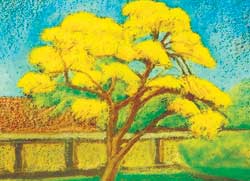
Bringing back Beling
It was a memorable Christmas gathering of the Beling clan last year. For when it was time for exchanging gifts, there was a special gift for each and everyone- the children and grandchildren of Geoffrey Beling: a crayon sketch by the artist himself. Daughter Ruth Dunuwille had unearthed the drawings, neatly tucked away in a folder quite by chance in her home and decided that each family member should have one. “There were phone calls to the children living abroad, to tell them of the special gift awaiting them,” recalls Beling’s youngest daughter Mary Anne Philip, relating how happy they had all been.
And from the joy this gift evoked came the idea of sharing Beling’s special talents with the public in this exhibition, aptly titled ‘Sketchbook’. It comes as some surprise that there has never been a solo exhibition of Geoffrey Beling’s work, though of course, since 1930 when his paintings were first shown with George Keyt, they have been exhibited with the ’43 Group. The family then began to contact his friends, both here and abroad among them Richard Gabriel, the only surviving member of the ’43 Group now in Australia who contributed the foreword for the catalogue for the exhibition and writer Neville Weeraratne who contributed an article on Beling’s work and will also be present at the exhibition. “My father had more or less stopped painting by the time I grew up,” says Ms. Philip, though she recalls vividly, family holidays when her father would stop the vehicle suddenly, pull out his sketchbook and make a drawing. One such sketch done in crayon on holiday in Belihuloya, she recalls, was gifted to her brother and his bride in 1969 after their honeymoon at the same spot. In later years, failing sight kept him from working much, though when a particular subject caught his eye, out would come the sketchbook, as it did in the case of the portrait of a family friend Greta White done when she came visiting one day and was captured relaxing in a chair. “We don’t really know how many paintings he did because in some instances, he didn’t even sign them. We may not have even seen some of them,” says Ms. Philip, adding that growing up, they had tended to take his talent for granted. “I remember dying of embarrassment, when once he came to my school on an official visit,” she laughs, speaking of the days when her father was Chief Inspector of Art in the Education Department, a post he held from 1932 until his retirement in 1967 and the many exhibitions he organised for schoolchildren. More than painting himself, his passion was to modernize the art curriculum into one that allowed a more spontaneous and uninhibited expression of their talents. Putting together the exhibition has been very much a family effort with Beling’s four children Paul, David, Ruth and Mary Anne and their children all contributing to bring Geoffrey Beling’s special gift to a new generation. Beling’s belief in the child Geoffrey Beling was a founder member of the ’43 Group, as well as the architect and designer of the Lionel Wendt Arts Centre. Beling’s best known paintings are in the galleries of the Lionel Wendt and the Sapumal Foundation, as well as in private collections both here and abroad. Beling succeeded C.F. Winzer as the Chief Inspector of Art of the Education Department of Ceylon in 1932. During his years in office as Chief Inspector of Art, he was able to liberate first the teachers, and then the students, in their study and expression of art. Geoffrey Beling believed that anything a child did, because of the simplicity and honesty of children, had to be beautiful. When he first introduced the idea of Child Art in Ceylon, he was more interested in bringing out what the child really enjoyed and believed, than in the “aesthetic” aspect of what children could do. “He became influenced by cubism after Lionel Wendt brought some prints of Picasso down,” says art critic Michael Anthonisz, commenting too on Beling’s links with Cora Abraham and the Melbourne Art School and the windows they opened for succeeding artists. |
|
||||||
|| Front
Page | News | Editorial | Columns | Sports | Plus | Financial
Times | International | Mirror | TV
Times | Funday
Times || |
| |
Reproduction of articles permitted when used without any alterations to contents and a link to the source page.
|
© Copyright
2008 | Wijeya
Newspapers Ltd.Colombo. Sri Lanka. All Rights Reserved. |

